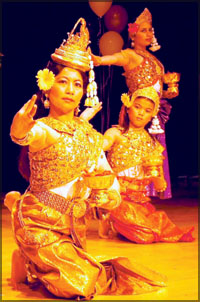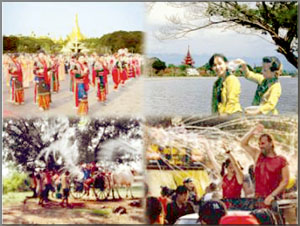It's New Year time in SE Asia
New Year celebrations will soon begin in South and
South East Asia. From Sri Lanka and S. India to Laos in the Far East,
people will be celebrating the dawn of a New Year this weekend. All
these countries are Buddhist, except Tamil Nadu (India) which is
predominantly Hindu.
Thailand
Songkran is the gayest of Thailand's national festivals. It
starts on April 13 and goes on for three days. Songkran is from the
Sanskrit word Sankranti meaning transition (going from one point to
another).
It is a word familiar to us, for we hear it used in connection with
our new year rites. In astrology, Sankranti is the transition of the Sun from the sign Pisces to Aries to begin a new
round of the Zodiac. This is explained elsewhere in this issue.
the transition of the Sun from the sign Pisces to Aries to begin a new
round of the Zodiac. This is explained elsewhere in this issue.
A thorough cleaning of the house before Songkran is a must in
Thailand. Housewives will throw out and make a bonfire of old clothes,
broken utensils and furniture and all other useless things that get
collected over the year. Keeping anything old and useless brings bad
luck to the owner and the home.
Not only are homes cleaned and brightened up, temple premises are
also cleaned and Buddha images bathed.
On New Year's Day, young and old dressed in new clothes visit the Wat
(vihara/temple) and offer food to the monks. On returning home, the
children pour scented water on the hands of parents and elders as a mark
of respect and get their blessings.
A colourful item in the Songkran festival is the releasing of
birds and fish. In Bangkok young girls beautifully dressed go in
procession to the river carrying bowls of fish, to be released into the
river.
In towns, birds and fish are on sale at markets at this time of the
year, but in the countryside, especially in the central plains, farmers
catch the small fish trapped in pools after the heavy rains and keep
them in their homes to be released into canals and streams at Songkran.
Throwing water on each other and on passers-by is the merriest part
of Songkran. Wherever one happens to be during Songkran, in the capital,
in a town or in a village in the north, one cannot escape being
drenched. This being the hottest time of the year, being doused with a
bucket of water is very welcome.
There is an ancient belief among the Thais that Nagas or mythical
serpents spouted water from the sea. The more they spouted, the more
rain there was. Water-throwing at Songkran is said to be a survival of
an ancient rite to bring on rain. Choosing a Songkran Queen, the
counterpart of our Avurudu Kumari is a popular event at Chiang Mai,
Thailand's popular tourist resort.
***
Myanmar
Ngo trees in full bloom herald the New Year in Myanmar, like the
erabadu, putting forth buds to remind us in Sri Lanka that the New Year is near. I am sure you know the 'raban pada'
that says:
Lanka that the New Year is near. I am sure you know the 'raban pada'
that says:
Erabadu mal pottu pottu avuruddath kittu kittu.
In Myanmar, the New Year festival is called Thingyam. It means
transition, same as Songkran.
Water throwing is a part of the Thingyam festival too. Water throwing
brings the old year to a close and ushers in the new, on April 13/14.
Young men go around in floats mounted on vehicles, squirting water on
everyone they pass, or throwing water on them.
I am not sure whether young women join them. However, women have
special liberties that day, so they too throw water on males, relations,
friends and strangers. There is so much fun on the streets, no one stays
indoors, anyone standing by the roadside is sure to get drenched as the
floats carrying the revellers pass.
Water is plentiful in Yangoon, the capital, and at the end of the
day, the streets are like channels. But in the north and in the interior
of Myanmar, it is dry and water is scarce.
The little water that is available has to be used carefully. When
friends, relatives and acquaintances meet, it is the custom to sprinkle
a little water on the neck from a bowl with a twig.
Pouring or sprinkling water is symbolic of cleansing the mind and
body of all the evils of the past year.
After three days of 'Water throwing', the streets of Yangoon are
quiet and deserted. The New Year has dawned. Men, women and children are
following a troupe of drummers to the temple, to bathe the Buddha
images. The pious and the elderly are already at the temple, making
their devotions. Some are observing 'Ata Sil' as on a full moon poya
day. Others bring alms for the bhikkhus.
At some temples, there is mass ordination of boys and young men. They
are free to give up the robe at any time they wish.
In the homes, a special sweetmeat has been prepared with rice,
jaggery and raisins. Sons and daughters go with gifts of fruits to pay
their respects to parents and grandparents. They also visit their
teachers with fruits as gifts.
Releasing animals from captivity on New Year's day is considered an
especially meritorious act. Fish and cattle, not birds as in Thailand,
are set free.
There is singing and dancing at decorated pandals. There are singing
competitions too.
****
Cambodia
From April 12, for three days, all Cambodia is celebrating the New
Year. The capital Phnom Penh is desolate as all schools and offices are closed and people have left for rural areas
to escape the unbearable heat of the city.
all schools and offices are closed and people have left for rural areas
to escape the unbearable heat of the city.
National flags on rooftops flutter in the wind and entrances to
temples are decked with flowers and creepers. In the temple premises, a
monk sits on a wooden dais, talking to devotees or explaining a
religious text. Elsewhere, young people are making sand hills and making
New Year wishes.
Buddha statues have been washed and the temple ground made spotlessly
clean for the New Year. In Cambodia, bathing Buddha statues is a
symbolic act to induce rain, without which an agricultural community
cannot survive.
Everywhere, young and old and the middle aged are all playing their
traditional games. Every district has its own special games, and some
games are played only at New Year. Of the national games, the tug’o’war
is the most popular.
Instead of the usual rope, here in Cambodia, the rope is made in the
form of a serpent. The Naga or serpent has a special place in Cambodian
mythology. The leaders of the two teams,one male the other female, are
chosen amidst much shouting and cheering.
The male team doesn’t win every time.
****
Laos
As in Sri Lanka, in Laos too the astrologer has an important part to
play in the New Year festival, Pimayu. People go to the astrologer to find out when exactly the New Year
begins. Laotians say as the presiding queen or princess of the year
makes her exit, the year ends. There is a gap in time between the exit
of the old queen and the arrival of the new queen. It is like our
nonagathay.
People go to the astrologer to find out when exactly the New Year
begins. Laotians say as the presiding queen or princess of the year
makes her exit, the year ends. There is a gap in time between the exit
of the old queen and the arrival of the new queen. It is like our
nonagathay.
The first day of the festival Pimayu is referred to as the ‘Day of
Departure’ and on that day, people are busy cleaning and tidying their
houses and compounds and getting ready to receive the new queen
princess.
Bathing Buddha images is an important activity on that day; people go
to the temple with bowls of scented water to help bhikkhus bathe and
clean the statues. Carrying sand to the temple is done as a duty on the
first day of the festival.
Sand is needed for repairs and for spreading on the temple compound.
Children enjoy themselves, making sand castles and decorating them with
flowers and flags and even currency notes. Two friends will make a mound
together, making the wish that their friendship continues.As in Myanmar
and Thailand, water throwing is very much a part of the festival and
very welcome to the ‘victims.’
In Laos too, it is symbolic of washing away the sins of the past 12
months. On the second day the people are without a ‘Guardian’. The old
queen has departed and the new queen has not come yet.
So people avoid any work that could cause harm or injury to oneself
or to others. On the third day, the new queen comes, ushering in the New
Year and everyone is relieved, and happy. People flock to the temples to
offer food and flowers and pass on the merit to her for the good luck
she has brought and for renewing their hopes.
Returning home, children sprinkle scented water on their parents and
promise to be good and obedient. The day is spent in feasting and
merry-making. The water throwing continues right through the three-day
festival.
****
Sumana Saparamadu
This account is based on information
gathered from a UNESCO publication for children on Festivals of India,
and on information provided by the Embassies of Myanmar and Thailand to
the writer sometime ago. |
